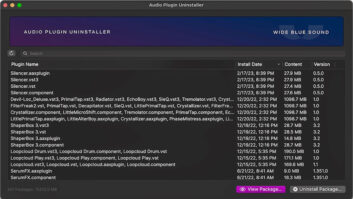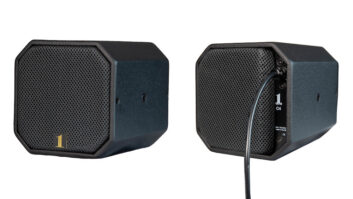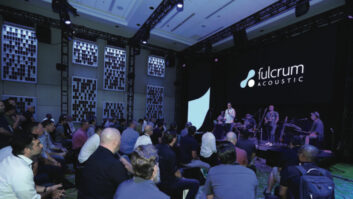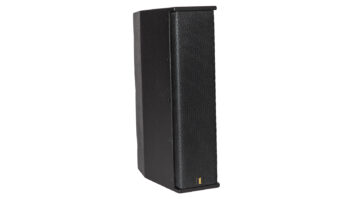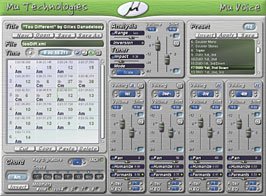
Mu Voice shown in Read mode. The position of the cursor is determined by the timing information of the host.
Correcting intonation problems and performing wild harmonic effects are two processes that aren’t often mentioned in the same sentence by most engineers. This may explain why so many plug-ins fall on one side of the “pitch” fence or the other. But Mu Technologies addresses both aspects of processing pitch with Mu Voice, a four-part harmony processor that takes into account the musical context of a piece, such as chord and scale information, while relying on a powerful tuning engine that corrects to the nearest half-tone or to the nearest note from the scale.
Input material must be monophonic and sampled at 44.1 kHz. Mu Voice gives you control over each harmony voice, offering a large assortment of filter-, formant- and harmonic-based special effects. With an internal latency of just 5.8 ms, this real-time plug-in requires no load time or offline pre-processing. On the Mac, it supports VST, Audio Units and RTAS formats, as well as Universal Binary (under OS 10.4 or later), and it supports VST and RTAS under Windows XP. Mu Voice is authorized using the PACE iLok system; a dongle is not included.
MEET THE PANELISTS
After launching Mu Voice, I immediately encountered its inviting, musician-friendly vibe. Instead of offering the typical, sterile calculator approach of old-fashioned harmony displays, Mu Voice’s GUI operates more like a conventional mixing console and chord chart. Prominently displayed is the Voicing panel configured as a 4-track harmony mixer. At the top of each channel is a tiny display box where you can assign one of four harmonic parts, or “voices,” for that track. For example, to harmonize an incoming signal according to the C chord in the C-major scale, no pitch shifting will be applied to the lead voice; the second voice will produce the lowest note above the leading note (when the lead voice sings C, the second voice will sing E); and the third voice will produce the second-lowest note above the leading note, or G in this case.
For harmonies to sound natural, though, they must also fit into any changing musical context. Mu Voice uses tables that define which note should be used for the second, third and fourth voice based on the desired scale, chord and leading note. Using the same example as above, if the lead voice were to sing G, the second voice would produce C and the third would produce E. The fourth voice is simply the octave of the lead voice; if there are modifiers, then they will be applied here.
Harmony parts can be shifted up or down by as much as one or two octaves. A special pitch-shift slider lets you adjust pitch manually or perform glissandos, the range of which is expressed as a decimal figure and can be half-tone-quantized. As the desired balance and number of harmony parts can change over the course of a song, there is a gain control and Mute button on each channel to automate voices on and off.
The Analysis panel offers global control over behavior of both the pitch analyzer and tuner circuitry. Using a range control, you can set the analyzer to search for low-pitched voices and instruments (the default setting) or adjust it to detect higher-pitched notes, avoiding artifacts. Tuning can be set to chromatic or scale, and the tuner’s impact can be adjusted for rounding values from none to the exact pitch. A global volume/shift slider operates on all harmonies simultaneously.
PANNING AND FX
Mu Voice’s panning feature is neat: It uses a binaural spatialization technique derived from psychoacoustic measurements to place and create the perceived angle of a given vocal harmony. A pan slider on each channel can “direct” sound along an azimuth of -90 to +90 degrees.
In addition to the voicing controls, each channel has a set of effects parameters. The Humanizing slider adds slight random-pitch variation and delay to harmonies whose pitches are coupled so tightly that they might otherwise interfere and be perceived as a single distorted voice. Formants are maintained by default when altering pitch, but timbre (gender-bending) can be warped manually or switched out entirely. Each voice channel also features a multimode filter with settings for high- and lowpass (positioned at a 4kHz cut-off); bandpass (400 to 4k Hz); and comb and inverse comb filters with resonances at multiples of 300, 600 and 1.2k Hz.
THE GRAND SCHEME
Voicing configurations are saved as presets that can be arranged into a song along with chord choices. The Chord Scheme panel is a scrollable matrix of cells where you can add scales and chords at specific musical events that automatically synchronize to the host clock. This interface is straightforward: Select a given key signature from a small panel located just beneath the matrix, and the diatonic series of chords is displayed along with chord modifiers like sus4, 6, 7 and 9. By clicking the chords and modifiers, a chord is selected for harmonization.
Once a song’s chord scheme is defined, computer keyboard events can be used (from hosts that support them) to trigger a corresponding cell’s voicing preset and/or chord simultaneously. Each cell displays chord, scale, preset number and time-stamp indication for a concise overview of a song.
HEAR IT SING
Mu Voice ships with 36 voicing presets covering everything from common clusters (duo, trio, quartet maj7 and minor7) to voice doubler/triplers, imaging/panning and filter/harmonic EQ effects. After quickly auditioning the presets, I couldn’t wait to dig into a female alternative-rock project that I’d just begun mixing. The lead vocal was great and well executed, and the pitch was nearly spot-on. However, the background vocals were not well produced, offering a chance to test out Mu Voice.
The factory programs offer great jumping-off points. I referenced the “Duo 1st, 2nd” preset for the song’s pre-chorus and the “Trio 1st, 2nd, 3rd down” for accentuating certain words in the chorus. I was also provided with several unison tracks from which to pick and choose during mixing. While I prefer the genuine article, I gave Mu Voice’s Doubler Stereo program a try. The result was smooth, wide and tightly chorused, and the plug-in’s humanize algorithm did wonderful things to keep the effect from sounding like an effect. One feature I’d like added here would be a modulated/automatable slider to let you adjust the “lateness” of each doubled part on a syllable-by-syllable basis for even more realism.
On the pre-chorus duet, I experimented with the second voice singing above and below the lead. Playfully taking it to extremes, I was impressed by how the vocal retained its original character and quality, going up by as much as seven or eight semitones. Even at a full octave, the singer clearly hadn’t been transformed into someone else, let alone a young girl or chipmunk. Going down was a slightly different story, with one or two semitones being the limit before the “throat length” really started to change and, at even lower settings, weird audio stretching artifacts made solo use completely out of the question. Lower parts can certainly hold their own in a three- or four-part harmony, kept fairly low in the mix.
In developing the trio preset, I appreciated all the voicing parameters in the Harmony mixer. It was great fun to “place” the vocalists around the mic using the directional panning, automate their individual levels, fine-tune the formants and create interesting harmonic landscapes using oddball effects — such as a telephone filter — on the lead vocalist during harmony parts.
A “lazy” vocal track can present a tug-of-war between seeking pitch accuracy and retaining expression. This is where the sliders for analyzing range and setting the tuner’s impact made Mu Voice respond musically to this particular vocalist, who stylistically bends and whines a lot. In this instance, I could zero in on a sweet spot where Mu Voice picked up lines that sounded a little flat without slamming drifting notes or creating expressionless jumps. Overall, the expressive nuances of the original performance were well preserved.
AN INTELLIGENT CHOICE
The Chord Scheme’s lookup tables are deep and flexible; plus, its ability to simultaneously administer chord and voice properties make Mu Voice a truly “intelligent” harmony processor. And with forthcoming MIDI support, this plug-in should become even more fun and immediately usable, particularly in live settings and for experimenting in the studio. Mu Voice can satisfy both the musician and tweak-head in all of us. Price: $279.
Mu Technologies, www.mu-technologies.com.
Jason Scott Alexander is a producer/mixer/remixer based in Ottawa, Canada.


